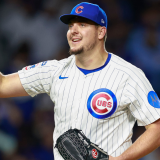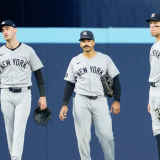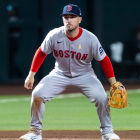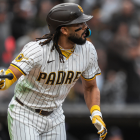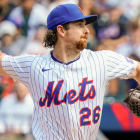
What's next for Red Sox after Sonny Gray trade? Boston shouldn't wait long to make more upgrades
The Red Sox made one of the offseason's first notable moves by landing Gray on Tuesday

BOSTON -- The Red Sox made their first real move of the offseason on Tuesday, landing right-hander Sonny Gray from the Cardinals for pitchers Brandon Clarke and Richard Fitts.
For Boston, Gray gives the Sox a veteran with a long track record of getting outs, missing bats, and filling up the zone. His 4.28 ERA in 2025 came with a brutal June that skewed the line, but he still struck out 201 in 180 ⅔ innings. It's the kind of swing-and-miss presence the Red Sox lacked last season outside of Garrett Crochet.
"The strikeout rate and walk rate are a good place to start," Red Sox chief baseball officer Craig Breslow said Tuesday evening. "Beyond that though he is a guy whose secondaries make up a significant part of the arsenal, and particularly, the sweeper and curveball are just two really, really good pitches. You can look at the whiff rates and the chase rates on the sweeper and say, like this, this is the foundation of a really strong arsenal."
Still, this shouldn't be the move that defines their offseason on the pitching side. And it probably won't be. But for that to hold true, everything has to line up for a Red Sox organization that has shown, at times, a reluctance to make the big splash (with the exception of the Crochet deal during last year's Winter Meetings).
The Red Sox have been tied to starter Joe Ryan since the trade deadline and are expected to make another run at the Twins righty this offseason with Minnesota's future in flux. How aggressive that push becomes is still to be determined.
Gray has put together a quality career, but his age brings real questions. He just turned 36 this month, and even though he made 32 starts in 2025, durability always becomes part of the conversation at that stage. The Red Sox still need a true No. 2 starter, and Ryan would be the obvious fit there, pushing Gray into the No. 3 or No. 4 slot. Still, the Sox view Ryan, who will not turn 30 until June, through a lens that is not far off from how they see Gray. Both have the swing-and-miss traits they value.
The organization also tends to prioritize overall starting depth more than strict rotation labels. They believe they have capable arms who can be part of the mix. Brayan Bello delivered a promising season and tapped into some of the potential that had shown up only in flashes during the previous two years. Connelly Early showed promise, too, in his first taste of the big leagues toward the end of last season. Payton Tolle has shown the stuff. Now it's about if he has the command. Kutter Crawford will be back a part of the mix after missing all of 2025 due to a myriad of injuries.
"I think this will be an important development year for a number of our guys," Breslow said. "And exactly where that takes place, I'm not sure, and the speed that it takes place at, I'm not sure. But knowing that you know guys like Early, Tolle, [Kyle] Harrison, [Luis] Perales, Hunter Dobbins and others are all capable of taking a step forward and working their way to the front of the rotation, we want to leave them the opportunity to do so. We also need to make sure that we're not becoming so reliant on guys that need to continue to develop that we find ourselves handicapping our chances in the short term."
Breslow should probably lean into the Ryan idea more than the idea of relying more on young arms. Development isn't linear, and if those are the starters the Red Sox plan to roll out in 2026, it would be a gamble few people outside the organization would be willing to take.
Offensively is where the Red Sox still need to do most of their work, and Breslow made it clear that remains the priority.
"I've been pretty transparent about our desire to add to the rotation and our desire to add a bat on the position player side," Breslow added. "It's impossible to know exactly what the order of operations will be, so we'll continue to look for opportunities to improve the team."
The loss of Rafael Devers in June's surprising trade with the Giants could really show itself if the Sox don't capitalize on the offensive market. They lack slug, and with Alex Bregman opting out of the two years left on his deal, that shortage becomes an even bigger problem.
The team is still tied to Bregman, and you can expect them to make a run at him as well as first baseman Pete Alonso, both Scott Boras clients. That usually means no discounts, since Boras, sometimes to the detriment of his own players, is known for pushing hard for top dollar.
The Sox waited out Bregman's market last year. Once he and Boras realized the interest was not what they expected, Boston pounced and signed him just before spring training in February. Alonso went through a similar situation, not re-signing with the Mets until February. Waiting it out worked in the Red Sox's favor.
But that approach could turn into a real risk this time around for Boston. And on both the offensive side and on the hill, it might not be a risk worth taking.





